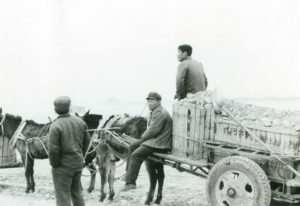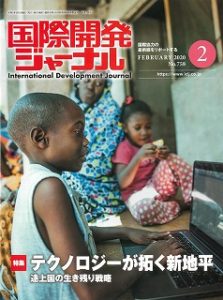Photo Exhibition of Japan’ s ODA held in China
picture:Qinhuangdao Port Expansion Project (the first Japan’s ODA to China)©The International Development Journal Co., Ltd.
IDJ ENGLISH
『International Development Journal』2020 February edition
More than 3.2 trillion yen loan to China
Official Development Assistance (ODA) to China to support the policy of “Reform and Opening-up” will end at the end of FY 2021. Taking such opportunity, in December 2019, a joint photo exhibition and symposium on the 40th anniversary of Japan’s ODA with China was jointly held by the Japan International Cooperation Agency (JICA) and Tsinghua University in Beijing to commemorate the 40th year of Japan’s ODA to China that began in February, 1979. At the opening ceremony, former Prime Minister, Yasuo Fukuda, was in attendance to make a speech. It was his father, former Prime Minister Takeo Fukuda, signed the Japan-China Peace Friendship Treaty in 1978.
The photo exhibition was entitled “Building a New Era in Japan-China Relations— Trajectories and Achievements of Japan-China Economic Cooperation since Reform and Opening-up”. It was assisted by the International Cooperation Bureau of the Ministry of Science and Technology, the International Finance Cooperation Bureau of the Ministry of Finance, and the Embassy of Japan in China.
According to the Ministry of Finance of China, the total amount of Japan’s ODA loans to China from 1979 to 2007 was 3 trillion and 216 billion yen for 231 projects. The target fields cover a wide range of industries including agriculture, transportation, energy, communications, environmental protection and human resource development. According to the Ministry of Science and Technology of China, 131 technical cooperation projects, 212 development studies, 37,335 training programs, 9,490 dispatch of Japanese experts, 855 volunteers, and 190 Grassroots technical cooperation have been implemented, with a cumulative total of 185 billion yen.
In the infrastructure field, many port development projects were progressed in Qinhuangdao, Dalian, Hebei, Qingdao, Lianyung, Shanghai, Baoshan, Shenzhen and Hainan Island. Airport projects included Shanghai Pudong International Airport, Beijing, Wuhan, Xi’an, Lanzhou, Urumqi and some others were implemented. In power development field, seven hydropower projects and five thermal power projects were also completed.
In particular, forestry projects including tree planting should be evaluated highly. They strongly contributed to the prevention of desertification and toward land conservation. The desertification phenomenon is happening even near Beijing and many places are also under threat of desertification.
In 2007, the Japanese ODA loan unit signed a memorandum of understanding with China’s National Environmental Protection Agency on national environmental protection cooperation. The Japan-China Friendship Center for Environmental Protection was established by grant assistance. Environmental damage in China has been serious and has been described as an “environmental department store,” including greenhouse gas emissions, air pollution, marine pollution and desertification. The Chinese government doubled its environmental investment in the ninth Five-Year Plan (1996-2000), and Japanese ODA loans accounted for about 10% of the total environmental investment. About 3% of foreign funds are allocated for environmental improvement and prevention. In particular, the introduction of a recycling-oriented economic policy, aimed at reuse of factory exhaust gas and recycling of waste, is highly evaluated.
Spirit of Reform and Opening Policy
Now, I want to get into the main topic here.
The Secretariat stated its intention of holding a “Symposium and Photo Exhibition on the 40th Anniversary of the commencement of Japanese ODA to China”; “Chinese and economic development from the “Reform and Opening policy up to the Xi Jinping’s “New Era”, and Japan-China economic and technical cooperation activity would be looked back upon. Through this process, we hope especially young people and citizens of China to take notice and reconsider this period of history.”
How do you look back upon the past while looking toward the future? It is a good subject when you think about China today. There are various ideas about this. For example, today’s Xi Jinping’s “New Era” has been realized precisely because there were reform and opening policies from 1980. In the meantime, the aim of the symposium and exhibition event is for the younger generation to know how devotedly Japan has cooperated with China to cultivate bilateral friendship.
On the other hand, it seems that the dramatic growth of China looks back here and hopes that the younger generation of China will return to the beginnings of “Reform and Opening-up” and think about the future of China.
Last year, NHK’s program “Japanese who supported the reform and opening of China” attracted a lot of interest among Japanese people. As is well known, China escaped from post-Cultural Revolution turmoil largely because of the “Reform and Opening” policies led by Deng Xiaoping. Japan was one of the first countries to lend money to China in the hopes of an “open country” when the world was reluctant to lend to China. Japan provided funds for the construction of airports, ports, railways and electricity, that became the nation’s basic infrastructure, and Japan also supported China’s reform and opening-up.
Anxiety about the Xi Jinping Dynasty
The NHK program portrayed Japan’s efforts on the construction of the Baoshan Steel Works, which was the driving force of modernization in China. It also focused on a deep exchange between Gu Mu, former Vice Premier of China with Saburo Okita, former Foreign Minister of Japan, who played a dedicated role in rebuilding Japan after the World WarⅡ. It is said that Japan’s postwar reconstruction policy was a valuable reference for China’s economic construction. Mr. Okita’s lecture in Beijing on “Japan’s Post-war Reconstruction Policy” had a significant repercussion, extending to the Chinese leaders, and he became an advisor to China on reform and opening-up. This is symbolic of Japan’s intellectual contribution to China.
At the beginning of the reform and opening-up, China was certainly given the image of an “Open Country.” It was thought that the degree of freedom and opening would also increase. The political system, which was governed by the Communist Party’s collective leadership system, has now changed dramatically. The dictatorship of Xi Jinping is becoming a strong governing system like the successive dynasties of China’s emperors in the past. Many are worried about what the reforms and opening-up will be and how it will impact the future of China. It is not clear what the young people who watched this exhibition on Japan’s ODA in China really thought. But it would be good for the fast-growing China to take a stop for a while and look back on its past to build the trust of the people of the world. I want China to think about what a civilized open country should be. If only these thoughts can send a message to Chinese youth through the retrospective exhibition of China’s ODA, it will be a meaningful significance.
By Mitsuya Araki, Editor-in-chief of IDJ
*****以下、日本語原文*****
羅針盤 「温故知新」のODA中国写真展 気になる中国青年たちの現状認識
3兆2,000億円余の対中円借款
中国への政府開発援助(ODA) は「改革開放」を支援することから始まり、2021年度末をもってすべて終了することになった。そうした中、1979年2月から始まった対中ODAの40年目という節目となった2019年、12月7日から13日にわたり国際協力機構(JICA)と北京の清華大学との共催による「対中ODA40周年総括写真展・シンポジウム」が開催された。
開幕式では福田康夫元首相が出席してスピーチを行った。父の福田赳夫元首相は1978年に日中平和友好条約を結んでいる。写真展は、題して「新時代の日中関係を築く―改革は開放以来の日中経済協力の軌跡と成果」。後援は中国科学技術部国際協力局、財政部国際財政協力局、在中日本大使館だ。
中国財政部によると、対中円借款協力(中国は対中ODAは、いわゆる途上国援助ではないという立場をとっている)は、1979年から2007年までの最後の円借款を含めて合計3兆2,165億円、231プロジェクトに達している。対象分野は工業、農業、交通、エネルギー、通信、環境保全、人材育成と幅広い。さらに、中国科学技術部によると、40年間で131件の技術協力、212件の開発調査、3万7,335人の研修、9,490人の日本からの専門家派遣、855人のボランティア派遣、190件の草の根技術協力が実施され、その累計額は1,853.02億円に達する。インフラ関連では、港湾が秦皇島港湾拡充から始まり、大連、河北、青島、石臼湖、連雲、上海、宝山、深圳、海南島の港湾開発。空港は上海浦東国際空港に続いて北京、武漢、西安、蘭州、ウルムチなど。開発事業では水力の天生橋水力、五強渓ダム、北京十三陵 揚水発電所などの水力発電が7件。その他に火力発電の案件が5件実施された。
筆者は対中協力の中でも、国土保全を考えると砂漠化防止にも貢献する林業(植林)事業を注視し、その協力の純度を高く評価している。砂漠化現象は北京近郊にまで迫っているから、中国は砂漠化の脅威にもさらされている。 中国の国家環境保護協力については、2007年、円借款部門が中国の国家環境保護総局と覚書きを結んでいる。無償援助では日中友好環境保全センターを設立している。中国の環境被害は深刻で、例えば温室効果ガス排出、大気汚染、海洋汚染、砂漠化など、まさに“環境問題のデパート”と言われてきた。その中で、中国政府は第9次5カ年計画(1996年~ 2000年)で環境投資を倍増させ、日本からの円借款は環境総投資額の約10%。外国資金の約3%を環境改善、予防に充てている。なかでも、工場の排ガスの民間利用や廃棄物の再利用を目指す循環型経済政策の導入は高く評価される。
見失われたか改革開放の心
さて、ここで本題に入りたい。 今回の「対中ODA40周年総括写真展・シンポジウム」について、当事者は開催の意図をこう述べる。
「改革開放政策から習近平“新時代”に至るまでの中国の経済発展と、そこに関わっていた日中の経済技術協力活動を振り返り、特に中国の青年層や市民層がこの間の歴史を振り返るための参考にされることを期待した」
過去をどう振り返り、そして将来をどう展望するか。今の中国を考える時の良い命題だ。これにはいろいろな考えがある。例えばその一つは、1980年からの改革開放政策があったからこそ、今日の習近平“新時代”が到来した。その間、日本が友好のためにどれだけ献身的に協力したかを今の若い世代に知ってほしいという狙い。
もう一つは、劇的に成長した中国がここで過去を振り返り、「改革開放」の初心に戻って、中国の進むべき将来を中国の若い世代に考えてほしいという願いが込められているように思われる。
昨年はNHKの「中国改革開放を支えた日本人」という番組が多くの関心を集めた。周知のように、中国が文化大革命後の混迷期から脱出できたのも、鄧小平による「改革開放」政策によるところが大きい。日本は世界中が中国への融資を渋っている時に、「開かれた国」を願って先陣を切るように融資した国である。国家の基礎インフラともいうべき空港、港湾、鉄道、電力への建設資金を提供し、中国の改革・開放を援護した。
習近平王朝への不安
NHKの番組では、中国近代化の走りとなった宝山製鉄所建設をめぐる日本の悪戦苦闘劇が描かれ、次いで、中国経済再建のための政策立案に関しては、改革開放政策を担当した谷牧副首相と、戦後の日本再建のために献身的な役割を果たした元外相、大来佐武郎との厚い交流が取り上げられている。
中国の経済再建には、日本の戦後復興政策が貴重な参考になったと言われている。北京での大来氏の「日本の戦後復興政策」という講演が大反響を呼び、これが中国首脳部にまで及び、大来氏は改革開放のアドバイザーを務めることになる。これは日本の中国への知的貢献を代表するものになった。
改革開放が始まった頃の中国は、確かに「開かれた中国」というイメージが強く与えていた。自由開放度も高くなると考えられていた。政治体制は共産党による集団指導制がとられていたが、今では大きく変わった。習近平の独裁体制へと進み、中国歴代王朝の帝王のような支配体制を築こうとしている。今では改革開放とは何だったのかと、中国の将来に不安を抱く人は多い。
今回の対中ODA40年の回顧展を見学した青年たちが、何を思い、考えたかは判然としないが、急成長している中国は少し立ち止まって、過去を振り返りながら、世界の人々の信頼を得られているのか、文明的な開かれた国のあり方を考えてほしい。対中ODAの回顧展を通してこうした思いが中国の青年達に何らかのメッセージを送ることができたなら、開催意義は大きい。
国際開発ジャーナル 主幹 荒木光弥
『国際開発ジャーナル』2020年2月号掲載記事





